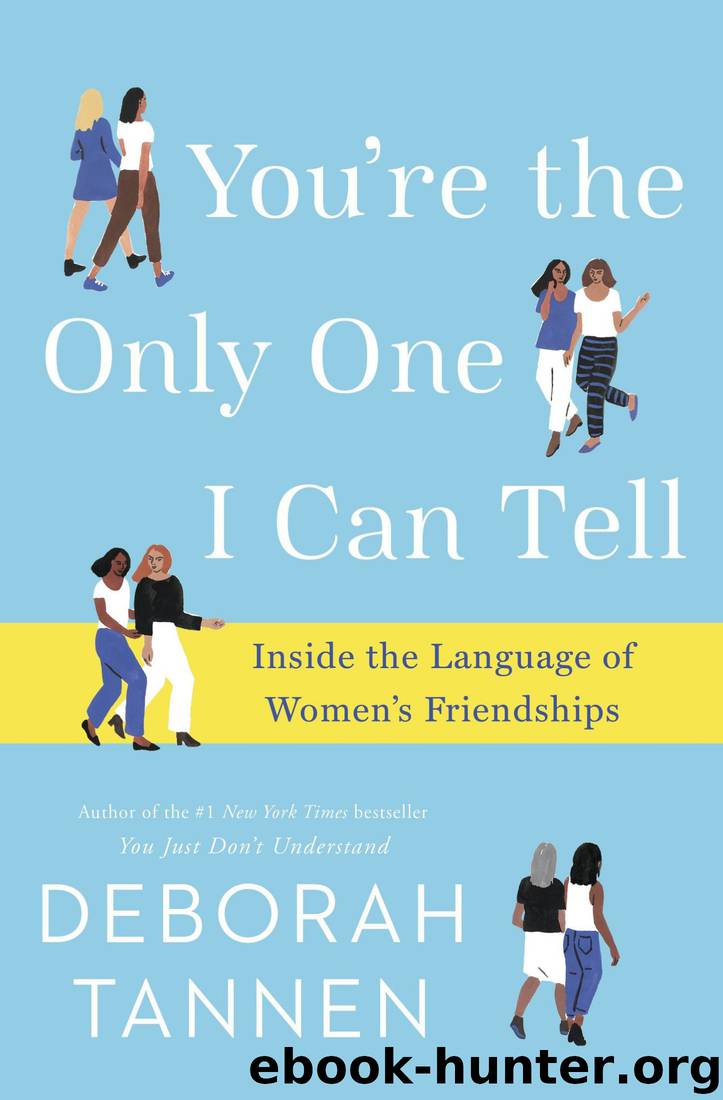You're the Only One I Can Tell: Inside the Language of Women's Friendships by Deborah Tannen

Author:Deborah Tannen
Language: eng
Format: epub
Tags: Non-Fiction, Psychology, Relationships, Feminism
Publisher: Random House Publishing Group
Published: 2017-05-02T00:00:00+00:00
Trios
There is comfort in groups. There is comfort in threes. Three, the minimalist group, takes the pressure off each individual to carry the conversation. Three defuses the intensity of one-on-one conversation, with its expectation, for women and girls, of unbroken gaze between listener and speaker—the spotlight on you alone.
I have a friend whom I first saw socially as part of a trio. We’d meet for dinner and go places together, always the three of us. As we all got to know each other better, I began also doing things as a pair—with one of the three, but not the other. Whenever I suggested to the other friend that we get together, just us two, she would decline. Finally, I told her I was getting the impression that she didn’t want to see me alone. She said I was right. But she assured me it wasn’t anything about me personally: she just feels more comfortable in threes, where she can recede into the background if she feels like it. With just one other person, the pressure to be always on, to find things to say, to spend the entire evening in the foreground, was daunting. This changed as we got to know each other better, and no longer prevents us getting together, just two. But it helped me understand why many women, especially early in a friendship, prefer threes.
The intensity of twos—especially between new acquaintances—takes a special form among lesbians, because of the possibility of sexual attraction. As one young woman, drawing on her own experience, explained, “Lesbians definitely prefer group settings when they are hanging out with new friends; otherwise, the message of friendship can be unclear. It can be confusing if a girl asks to hang out one on one, even if she says it is just friends, because there is still that uncertainty. A third or a group helps prevent that.” The way that threes can dispel that aspect of the intensity of twos apparently motivated Saint Augustine when he cautioned nuns in a convent to go to public baths in groups of three or more. But the involvement of a group presents other challenges. The young woman who said her lesbian friends prefer threes or groups at first went on to explain that groups entail risks as well: “If someone gets a crush on someone else and it is not reciprocated, the whole friend group ends up being involved in these awkward interactions. This happened with my group of five close friends. One girl got a crush on another and they both felt awkward, so then group interactions were awkward, too.” Partly (though not only) because of that awkwardness, and because the rest of the group felt closer to the girl she had a crush on, they edged her out of the group. Enter FOBLO.
Download
This site does not store any files on its server. We only index and link to content provided by other sites. Please contact the content providers to delete copyright contents if any and email us, we'll remove relevant links or contents immediately.
| Codependency | Conflict Management |
| Dating | Divorce |
| Friendship | Interpersonal Relations |
| Love & Loss | Love & Romance |
| Marriage | Mate Seeking |
The 5 Love Languages: The Secret to Love That Lasts by Gary Chapman(9588)
Doing It: Let's Talk About Sex... by Hannah Witton(9187)
Should I Stay or Should I Go? by Ramani Durvasula(7562)
The Road Less Traveled by M. Scott Peck(7522)
The Lost Art of Listening by Michael P. Nichols(7406)
Daring Greatly by Brene Brown(6444)
Beartown by Fredrik Backman(5596)
We Need to Talk by Celeste Headlee(5542)
Men In Love by Nancy Friday(5155)
The Rules Do Not Apply by Ariel Levy(4859)
The State of Affairs by Esther Perel(4639)
How To Win Friends and Influence People by Dale Carnegie(4443)
Reflections Of A Man by Mr. Amari Soul(4237)
Pillow Thoughts by Courtney Peppernell(4208)
The Ethical Slut by Janet W. Hardy(4173)
Algedonic by r.h. Sin(4011)
He's Just Not That Into You by Greg Behrendt & Liz Tuccillo(3831)
I Love You But I Don't Trust You by Mira Kirshenbaum(3805)
Surrounded by Idiots by Thomas Erikson(3773)
